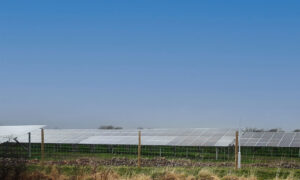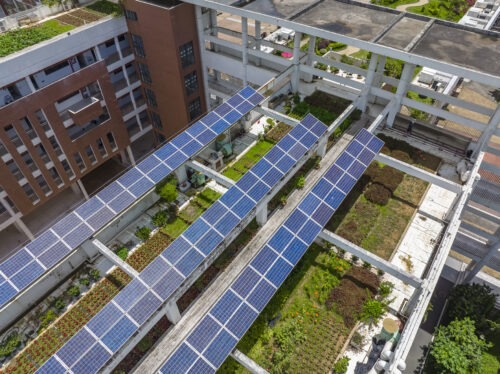- 18 | 07 | 24
Larkfield Leisure Centre rooftop solar installation
Case Study – See how rooftop solar is leading Larkfield Leisure Centre to net zero.
Are you wanting to explore what alternatives there are to energy? If so our blog dives into the various green alternatives, what it means to go green and how you organisation can make it happen.
In conjunction with Net Zero Week, we are taking a closer look at green energy alternatives. Join us below as we dive into not only what it means to be green, but also the changes you can make to your current energy sources and how we can help your organisation explore greener energy alternatives.
The term ‘Green Energy’ isn’t anything new yet as we globally work together towards combatting climate change more than ever it can still leave some a little confused.
Green Energy is clean and represents energy sources that have little or no environmental impact when they are used as they don’t release carbon emissions into the environment like fossil fuels do. Carbon emissions are caused by the burning of hydrocarbons and so by considering green energy alternative you are helping reduce carbon emissions that are emitted into the atmosphere.
Quite often Green Energy and Renewable Energy are used together, however there are subtle differences between the two that we feel are important to understand.
Green Energy is closely linked to Renewable Energy because all the energy sources that feature under green are renewable, but it can be argued that not all renewable resources of energy are green.
If we use wood as an example. This is a renewable energy source because it comes from trees, and we can plant trees to grow and replace the ones being used. However, if we use the burning of wood as an energy source, for heat or light, this will release carbon into the atmosphere. It is debatable about how ‘green’ this activity is due to whether the initial sequestration of the tree that was used for the wood does counteract the release of that carbon.
So, it is worth considering this when hearing the terms ‘Green’ and ‘Renewable’ when looking at energy sources. For the purpose of this blog post, we will refer to ‘Green’ energy and only concentrate on sources that reduce the release of emissions into the atmosphere (no matter whether it was original sequestered).

Therefore, the heightened awareness of Green Energy is increasing, and more people are looking at ways to harness this energy to reduce their carbon footprint and support the environment for the future. Choosing to go green means that more investment will be given to technologies that support Green Energy, making it a stronger solution but also more affordable for everyone.
When thinking about what you currently have in place in your organisation whether it’s electricity, transport or for your heating system; an important first step is to fully understand your carbon emissions. If you understand what emissions you are causing, from where and why, you can then start to look at alternatives. Understanding, measuring and monitoring your carbon footprint is something we can help you to look at with our Net Zero solutions.
For example, when it comes to emissions there are two parts, On-Site and Off-Site.
On-Site – These are emissions that you Release directly by your activities – such as using natural gas-fired heating or internal combustion engine (ICE) transport.
Off-Site – These are often referred to as Scope 2 & 3 emissions. Scope 2 emissions are those that produced offsite but by your activity. The main element here is electricity usage. You draw electricity from a grid that Is partially supplied by the burning of hydrocarbons (overwhelmingly natural gas). Scope 3 emissions are those caused by your supply chain. For example, you could count this as the use of a supplier to deliver goods to your buildings using an ICE vehicle. That is the supplier’s activity – however your ‘order’ of those goods has allowed the supplier to make that delivery. Scope 3 emissions are complex to account for however should be considered as part of the wider picture of the impact of your activities.
For the On-Site Scope 1 emissions, you could start by looking at how to reduce your consumption on site. This could include increasing the heat efficiency of your buildings (insulation, draft proofing, BMS systems). Or switching away from Scope 1 emissions by replacing traditional fuels with lower carbon alternatives such as electric heating using heat pumps or Electric Vehicles.
After this you can start to look at Off-Site and Scope 2 emissions. If we look at solar, you can investigate having roof top solar panels installed. Rooftop solar panels help to reduce your demand on the grid and reliance on third parties to supply you this energy through the grid – as well as reducing the electricity you need to buy through the meter. LED Lighting is also a great way to reduce your electricity demand and one that can be done effectively to work with your budgets but also a quick win to get things moving.
Once you’ve exhausted all the options on-site, you will more than likely still require to draw electricity from the grid. Therefore, you may want to satisfy that you are buying that electricity from a ‘green’ source. A potential solution here is to either invest & build an off-site renewable asset (such as a solar farm) to supply energy via the grid; or buy green electricity, direct and traceable, from a generator via a PPA (Power Purchase Agreement). This will greatly depend on your appetite for risk and accessibility to finances, but the good news is that they both help towards de-carbonisation.
To summarise the three ways to approach reducing your emissions are:
When it comes to exploring green energy we can help in several ways, however the solutions will depend on you, the individual customer, and what you’re looking for, your appetite for risk and access to finances. The four main ways we can help are:-
These options can be delivered via our frameworks designed for compliance with public procurement contract regulations.

the ongoing running of the solar farm from managing contractors, energy trading, monetary flows and carbon management and reporting.
In summary, we have experience in many areas of making your estate ‘greener’ as well as compliant routes-to-market to suit your needs, with varying levels of assistance that can be provided. And we would love to use that resource to help you on your Net Zero journey.
If your organisation would like to discuss and explore green alternatives or would like help in understanding your carbon emissions, please look at our Zero Carbon services and reach out to our team to have a conversation.

Case Study – See how rooftop solar is leading Larkfield Leisure Centre to net zero.

Chichester District Council, a council committed to sustainability, partnered with LASER to analyse the commercial viability of a Corporate Power Purchase Agreement for their energy supply.

Looking to become a ‘Smart School’ and embrace technology for reducing your energy usage and carbon footprint? If so, we hope you enjoy this blog where we dive into the various approaches and technologies your school can consider to help it reach its net zero goals.